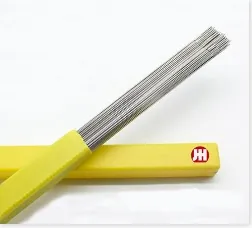Stainless Steel Welding Electrodes: Types, Prices, and How to Choose the Right One
Welding stainless steel presents a unique challenge. The material is strong, corrosion-resistant, and often used in critical environments—but only if the welds maintain those properties. That’s why selecting the correct stainless steel welding electrode is essential. It ensures structural integrity, corrosion resistance, and compliance with project specifications.
Whether you're fabricating process piping, food-grade tanks, architectural structures, or maintenance welds, knowing the right SS welding electrodes types—and their price points—can save you time, reduce rework, and improve weld performance.

What Are Stainless Steel Welding Electrodes?
Stainless steel welding electrodes are consumable rods used in shielded metal arc welding (SMAW) to join stainless steels. These electrodes have a core wire made of stainless alloy, covered with a flux coating that stabilizes the arc, provides shielding, and enhances metallurgical properties.
Unlike mild steel electrodes, SS electrodes must match the base metal’s alloy composition closely to ensure resistance to corrosion, oxidation, and cracking—especially in high-temperature or chemically aggressive environments.
SS Welding Electrodes Types (Most Common Classifications)
There are dozens of types of stainless steel welding electrodes, each tailored for specific grades, welding positions, or environmental conditions. Below are the most common AWS classifications:
1. E308L
For 304/304L stainless steel
Low carbon to prevent carbide precipitation
Excellent for food processing, dairy, and chemical tanks
2. E309L
Used to weld dissimilar metals (e.g., SS to carbon steel)
Common in structural transition joints and overlay welding
3. E316L
For 316/316L stainless steel
Added molybdenum for better pitting resistance in chloride environments
Ideal for marine, pharmaceutical, and chemical plants
4. E310
High-chromium, high-nickel electrode
Designed for high-temperature service, furnace parts, and heat exchangers
5. E347
Niobium-stabilized for intergranular corrosion resistance
Often used in high-temp piping and nuclear applications
6. E2209
For duplex stainless steels (22% Cr)
Balances strength and corrosion resistance in offshore, pressure vessel, and piping applications
Each electrode has a specific polarity (usually DCEP), welding position rating (1 = all position, 2 = flat/horizontal only), and flux composition that affects slag removal, arc smoothness, and spatter.
Choosing the Right SS Welding Electrode
Key selection factors include:
Base metal grade: Match the electrode chemistry as closely as possible to the base metal.
Weld position: For overhead or vertical welding, use “1” rated rods like E308L-16.
Service environment: Consider chemical exposure, saltwater, or high heat.
Joint configuration: Some electrodes offer better penetration or fill characteristics.
Always consult your Welding Procedure Specification (WPS) or a materials engineer for code-compliant work (e.g., ASME IX, AWS D1.6, API 1104).
Stainless Steel Welding Electrode Price
SS welding electrode price varies based on several factors:
|
Influencing Factor |
Tavsif |
|
Alloy type |
E308L is less expensive than molybdenum-rich E316L or duplex E2209 |
|
Electrode size |
Common sizes include 2.5mm, 3.2mm, 4.0mm—larger rods are slightly more expensive |
|
Packaging |
Sold by weight (kg or lbs), typically in 5kg or 20kg boxes |
|
Brend |
Premium brands like ESAB, Bohler, or Lincoln Electric cost more |
|
Quantity purchased |
Bulk pricing significantly lowers per-kg cost |
|
Country of origin |
Local manufacturers may offer better prices than imports |
Typical 2025 Price Range (USD per kg):
|
Electrode Type |
Price Range (USD/kg) |
|
E308L |
$6.00 – $8.50 |
|
E309L |
$6.50 – $9.00 |
|
E316L |
$7.50 – $11.00 |
|
E310 |
$9.00 – $13.00 |
|
E347 |
$8.00 – $12.00 |
|
E2209 |
$10.00 – $14.00 |
Premium coatings, moisture-resistant packaging, or nuclear-grade certifications can increase pricing by 10–20%.
Where to Buy: SS Welding Electrodes for Sale
Stainless steel welding electrodes are available through:
Local welding supply stores
Online industrial marketplaces
Authorized dealers of major brands
OEM manufacturers and private label producers (for bulk or contract use)
When sourcing, ensure the supplier provides:
AWS/ISO/EN certifications
Batch traceability and mill test reports (MTRs)
Storage and handling instructions
Post-sales support or application guidance
For large operations, some suppliers offer technical visits, sample packs, or support with WPS qualification.
Storage & Handling of SS Electrodes
Store in dry, low-humidity environments
Re-dry low-hydrogen rods like E308L-15 at 250–300°C for 1–2 hours before use
Use within 4 hours after opening vacuum-sealed packaging
Avoid moisture pickup to prevent porosity and cracking
Stainless Steel Welding Electrode FAQs
Q1: What’s the difference between E308 and E308L electrodes?
A: E308L has lower carbon content, reducing the risk of carbide precipitation and intergranular corrosion—especially in high-heat zones.
Q2: Can E309L be used for welding stainless to carbon steel?
A: Yes. E309L is the standard electrode for joining dissimilar metals and works well on stainless-to-mild steel transitions.
Q3: How do I know which SS electrode to use for high-chloride environments?
A: E316L is best for chloride resistance due to its molybdenum content. Use it for marine and chemical processing applications.
Q4: Why are stainless electrodes more expensive than mild steel rods?
A: SS electrodes contain alloying elements like nickel, chromium, and molybdenum, which are more costly to produce and refine.
Q5: Can I use stainless electrodes on a standard stick welder?
A: Yes, most SMAW machines (AC/DC) can run SS rods, but check the electrode’s polarity and your machine’s amperage range.
-
What is a medium-frequency pulse? What types of welding are suitable for?YangiliklarNov.24,2025
-
Why is the overall cost of CO2 welding lower than that of shielded metal arc welding?YangiliklarNov.21,2025
-
Welding Knowledge 6YangiliklarNov.20,2025
-
What is a low-frequency pulse? What types of welding are they suitable for?YangiliklarNov.19,2025
-
Why are the weld joints from CO₂ gas shielded welding of such high quality?YangiliklarNov.18,2025
-
J506 Welding Rod - Low Hydrogen, All-Position, AC/DC E7016YangiliklarNov.17,2025


